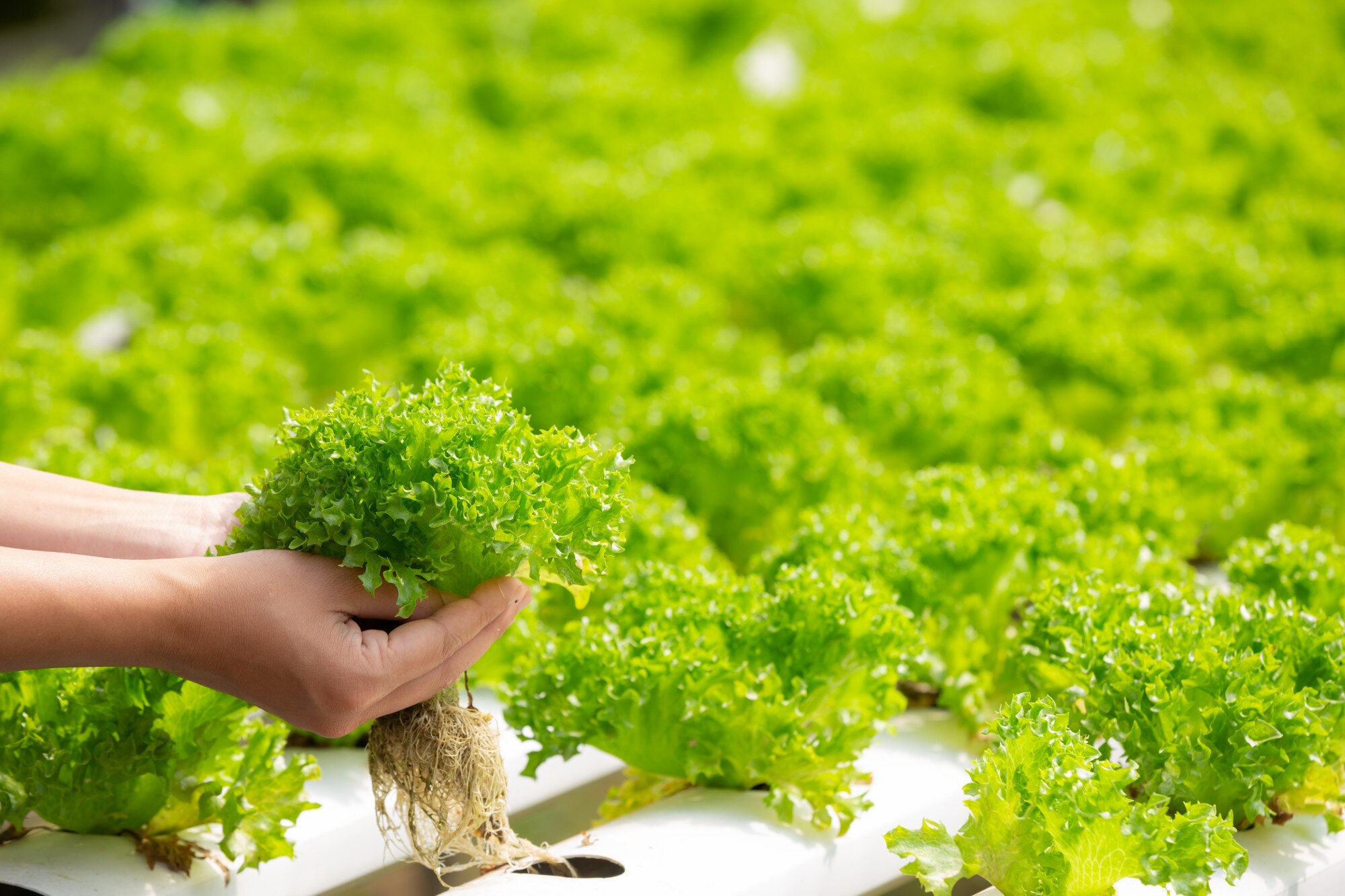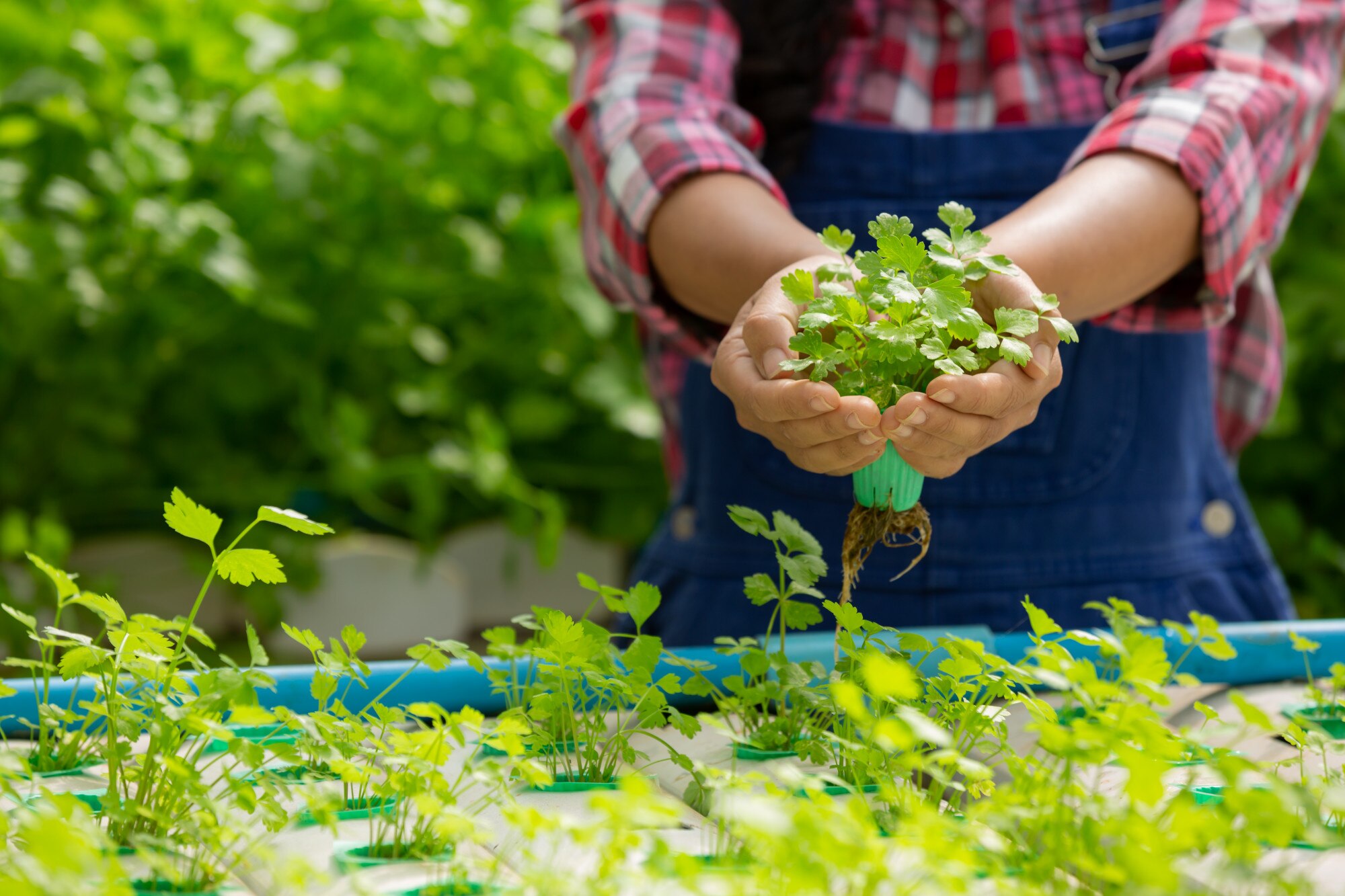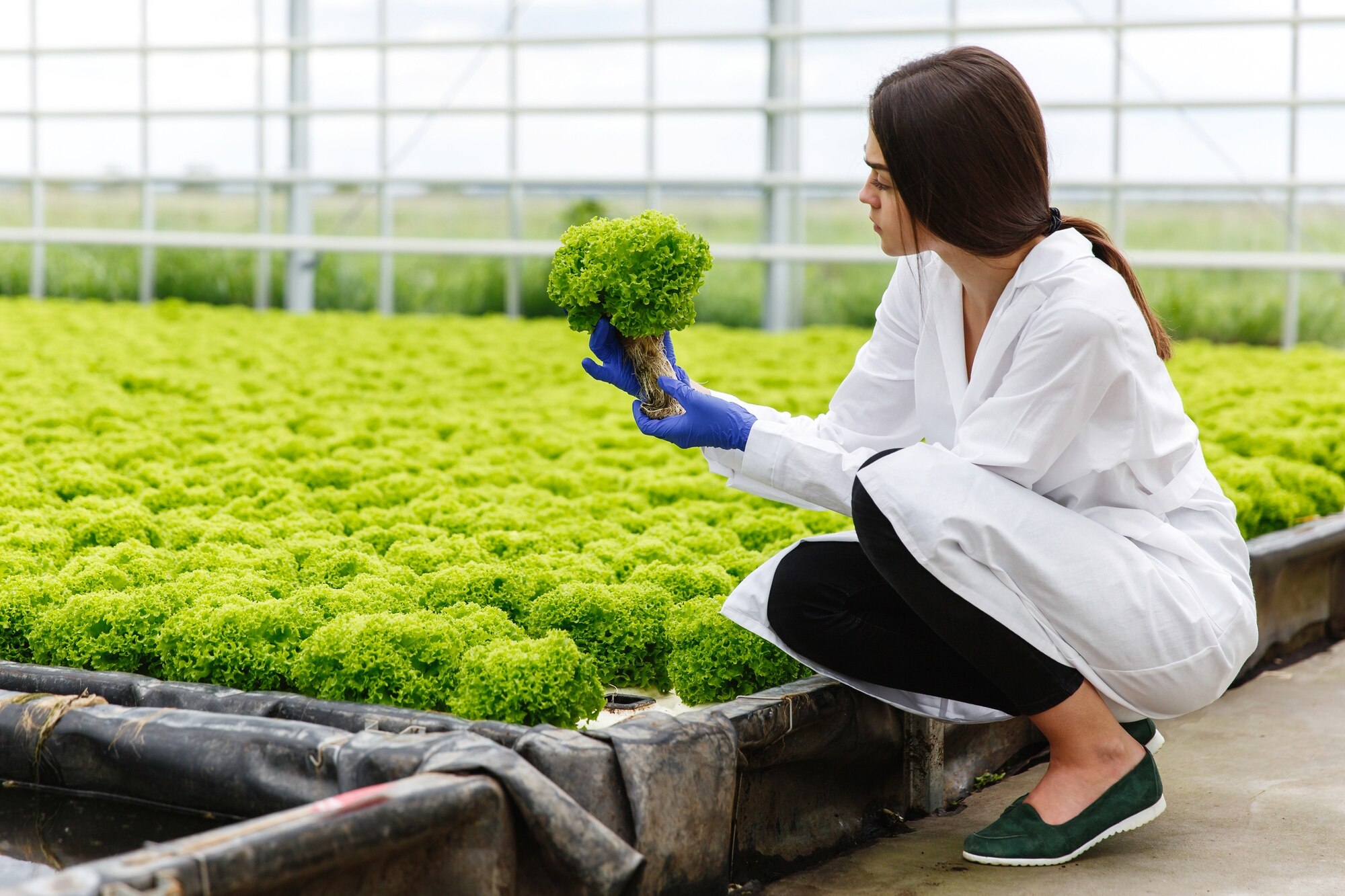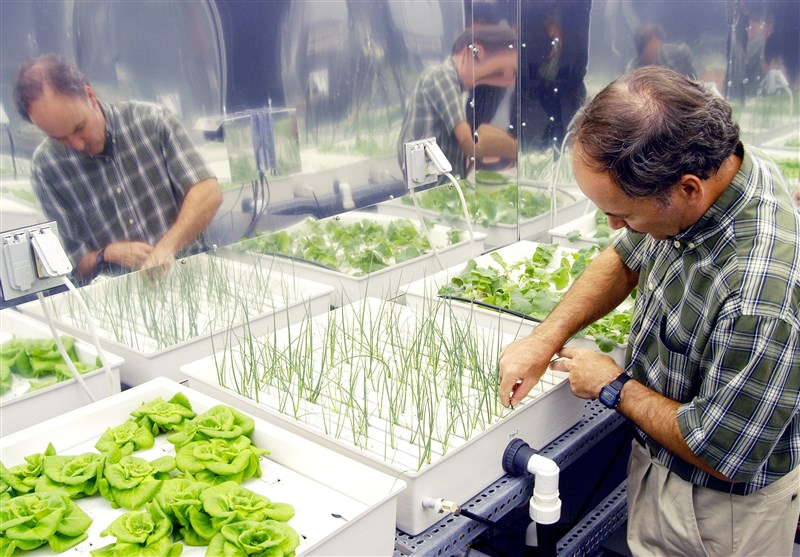Introduction: Hydroponic agriculture, as a new method of producing agricultural products, with an emphasis on high productivity and reduced resource consumption, has rapidly expanded its position in the world’s agriculture. This method, which is based on artificial, soil-free environments, was formed decades ago and is now considered one of the youngest and most innovative methods of producing agricultural products.
History: Hydroponic farming (soilless farming, water farming) has its roots in the 1930s, when it began as a new solution for producing crops in limited space and water conditions. Initially, the development of this method was limited to spatial coordinates, and then, with continuous improvements and scientific validation, researchers introduced hydroponic farming as a significant advance in the field of agriculture.
Importance and Need: In today’s world, where climate change, decreasing water resources, and the need for continuous production of agricultural products have become serious challenges, irrigated agriculture has emerged as an effective and responsive solution to these challenges. Using this modern method, it is possible to increase water efficiency, reduce the use of fertilizers and chemicals, and ultimately improve the yield and quality of products. This allows farmers to continue reliable and sustainable production in the face of environmental challenges and resource constraints.
Principles of hydroponic farming:
Explaining the basic principles of hydroponic farming and how it works:
Hydroponic farming is a modern method of agricultural production based on environmental and high-yield principles. In this method, the roots of plants are placed in liquid nutrient mixtures or a special medium containing nutrients. This medium can be water, nitrate solution, or other light media. The basic principles of hydroponic farming are:
- Root Environment Management: In hydroponic farming, the root environment must have the right and balanced nutrient composition. This fundamental principle is very crucial for healthy plant growth.
- pH control: Regulating the pH level of the environment around the roots is very important to prevent problems with nutrient absorption by plants.
- Providing light sources: Plants need adequate light for optimal performance. In hydroponic farming, the use of artificial light sources such as LED lamps is inevitable to meet the light needs of plants.
Comparison with traditional agricultural methods and the advantages and disadvantages of each:
- Advantages:
- High efficiency: Hydroponic farming generally has higher efficiency in water consumption.
- Precise control of nutrients: This method allows for more precise control of the amounts of nutrients required by the plant.
- Faster plant growth: Due to access to optimal nutrients, plants grow faster and healthier in hydroponic farming.
- Disadvantages:
- High cost: Setting up and maintaining a hydroponic farming system is expensive.
- Technical complexity: The need for specialized knowledge and skills in managing complex hydroponic systems is one of the challenges of this method.
Comparing these principles with traditional methods shows that hydroponic agriculture, as a modern method with high capabilities and reduced resource consumption, can contribute significantly to the improvement and productivity of the agricultural sector.

Types of hydroponic systems:
Hydroponic farming uses different types of systems to grow plants. Below, we will introduce the three main types of hydroponic systems and examine how each works:
1. NFT (Oil):
- In the NFT system, plant roots are placed in elongated tubes containing a nutrient solution.
- Water with needed nutrients continuously passes through the pipes and drips onto the roots.
- This system is very economical to operate and saves a lot of space, but it requires careful monitoring of water levels and pH.
2. DWC (Deep Water Culture):
- In the DWC system, the roots of the plants are placed directly in water that contains a nutrient solution.
- Plants in this system grow without any soil and are nourished only using water and nutrient solutions.
- It is simpler to operate than other systems and is suitable for plants that require a lot of water, such as cucumbers and tomatoes.
3. Combined systems:
- Hybrid systems involve combining different components of NFT and DWC systems.
- These systems utilize the advantages of both types of systems and are designed as a combination.
- Some of the benefits of these systems include increased productivity, reduced costs, and better control of the growing environment.
Performance comparison:
- The performance of each system depends on the type of plants and environmental conditions.
- NFT is usually used for plants with short stems, such as in greenhouses, because it is economical and uses less space to grow plants.
- DWC is very effective for plants that require a lot of water and have long stems, such as cucumbers and tomatoes.
- Hybrid systems can provide an appropriate combination of the advantages and disadvantages of both types of systems and can be used for different types of plants.
In general, the choice of a hydroponic system should be made according to the type of plants, environmental conditions, and the intended cultivation purpose.
Benefits of hydroponic farming:
Hydroponic farming has brought about unique benefits by improving agricultural systems and helping to improve the environment. Below are three main benefits of hydroponic farming:
1. Increasing water efficiency:
- One of the major benefits of hydroponic farming is the significant reduction in water consumption. In this method, water is managed in a cyclical and highly precise manner in the plant root environment.
- More accurate monitoring of the amount of water needed by plants leads to increased water use efficiency and improves water scarcity problems.
2. Reducing the use of fertilizers and chemicals:
- In hydroponic farming, a nutrient solution containing the nutrients needed by plants is carefully supplied.
- This method significantly reduces the use of fertilizers and chemicals, as nutrients are provided directly to plants in precise amounts. This leads to reduced soil and water pollution.
3. Increase the growth rate and yield of crops:
- Plants in a hydroponic environment have more precise access to nutrients, which leads to increased growth rate and crop yield.
- Healthier roots, standardized growing medium, and precise regulation of environmental factors found in hydroponics allow plants to reach their maximum potential.
These benefits indicate that hydroponic agriculture, as a modern method, has responded to the challenges of managing limited resources and protecting the environment, and has helped improve productivity and product quality.
Challenges and solutions for improving hydroponic agriculture: A path to improving performance and sustainability in soilless plant cultivation
Hydroponic farming, while it has many benefits and potential, also faces challenges. Below are some of these challenges and possible solutions to solve them:
A. Technical problems:
- Challenge: Technical problems such as deficiencies in irrigation systems, proper lighting, and temperature control can affect plant performance.
- Solution: Use advanced technologies such as smart sensors to more accurately monitor and control environmental conditions. Also, improve employee training and skills in equipment management and maintenance.
B. Costs:
- Challenge: Hydroponic systems are expensive to set up and maintain, including costs for equipment, labor, and food.
- Solution: Increase system productivity and efficiency, use low-cost technologies such as solar energy, and use effective management methods to reduce maintenance and production costs.
C. Management:
- Challenge: Proper management of hydroponic systems, including pH control, protecting plants from diseases and pests, and controlling water quality, requires knowledge and experience.
- Solution: Regular and up-to-date training of employees in systems management, use of modern management technologies, and partnership with hydroponic agriculture experts and consultants to solve problems and improve performance.
By implementing appropriate solutions, improvements and advancements in hydroponic agriculture can be made and the benefits of this method can be maximized.
Extensive applications of hydroponic agriculture: A new strategy for sustainable production, promotion of global markets, and creation of export opportunities
Hydroponic farming, as a new method of agricultural production, plays an important role in supplying specific products as well as developing local and global markets. Below are some of the widespread applications of this method:
A. Production in greenhouses and closed spaces:
- Hydroponic farming is very suitable for production in greenhouses and enclosed spaces due to the need for less physical space and the ability to more precisely control environmental conditions.
- Using this method in greenhouses leads to increased productivity, reduced consumption of resources such as water and fertilizer, and improved product quality.
B. Exporting and promoting local and global markets:
- Producing high-quality, valuable products using hydroponic agriculture can provide many opportunities for export to local and global markets.
- By providing high-quality products and a clean environment, this method can help strengthen the country’s reputation in exporting products and generate more income.
Given these widespread applications, hydroponic agriculture, as a new and promising method, can play an important role in food supply and economic development at the national and global levels.
7. Environmental and economic impacts of hydroponic farming:
Hydroponic agriculture causes changes in the environment and economy of countries. Below is an examination of the positive and negative effects of this method in both areas:
A. Environmental impacts of soilless farming:
-
Positive effects:
- Reduced water consumption: Hydroponic farming consumes the least amount of water compared to traditional farming methods and is effective in reducing water use for agriculture.
- Reduced use of fertilizers and chemicals: With careful control of food, the need to use fertilizers and chemicals is reduced, which helps maintain environmental balance.
- Reduces the need for large spaces: Hydroponic farming, as a space-saving method, promotes reduced land degradation and the conservation of natural resources.
-
Negative effects:
- High energy consumption: Hydroponic systems require a lot of energy, which can be a problem, especially in energy-constrained areas.
- Equipment materials: The production and maintenance of complex, resource-intensive equipment have negative impacts on the environment.
B. Economic impacts of irrigated agriculture:
-
Positive effects:
- Increased productivity: Producing high-quality products and greater productivity stimulates increased production levels and the country’s macroeconomy.
- Job Creation: The expansion of hydroponic agriculture helps create jobs in production, equipment maintenance, and growing environment management.
-
Negative effects:
- High cost: Setting up and maintaining hydroponic systems is expensive and may be a financial problem for some farmers.
- Dependence on technology: Dependence on advanced technologies can lead to economic problems if these technologies are unstable.
Long-term sustainability:
By establishing appropriate policies and standards in the field of environment and economy, hydroponic agriculture can contribute to long-term sustainability and help achieve a balance between increasing production and preserving the environment.
Hydroponic farming: Moving forward with global case studies for development and performance improvement.
Hydroponic farming has become a new agricultural method, drawing on successful case studies from around the world. Below are some case studies and their positive impacts on the development and advancement of hydroponic farming:
A: Iran’s entry into “hydroponic cultivation” with a 90 percent reduction in water consumption!
Official Twitter account of Tansim News Agency
According to a report by a scientific reporter at Tasnim News Agency, ” Hydroponic cultivation ” is one of the creative methods for producing agricultural products without soil and with minimal water requirements. Instead of growing in soil, the plant is placed in a nutrient solution, which has been popular throughout the country for some time. In this regard, Iranian researchers, using the soilless hydroponic cultivation method, consume 10 times less water, but their harvested products are many times greater!
Hydroponic cultivation is carried out on special trays and has direct contact with the plant, which must be in completely sterile conditions, and approximately 30 kg of fresh fodder can be produced per square meter every 10 days.
The 15-hectare Zarandieh hydroponic greenhouse complex, which produces summer varieties, especially tomatoes, is one of the leading agricultural complexes in this field.
Moghadamfar, the CEO of this complex, said about the method and details of this new type of cultivation in the country: The amount of tomato production in this greenhouse is about 3,600 tons of grade 1 and 2 products, and this complex is the second “high-tech” greenhouse in the country, with 55 percent of its products being exported.
He continued: “In this method, water is directly available to the plant and can be recycled for use by the plants. In this way, we have a higher yield than soil crops, which is approximately 3 times, and on the other hand, it consumes less water than similar crops.”
In Iran, dozens of greenhouses have been set up to produce agricultural products in this way. As an example, the Lorestan Agro-Industrial Company can be mentioned. Arabnejad, the CEO of this company, stated in this regard: Approximately 10,000 tons of tomatoes and sweet bell peppers are produced annually, and of this amount, approximately 70 percent of the product is exported to Russia countries in the cold season and to the Persian Gulf countries in the warm season. Of this 70 percent of the product, it will bring $5 million in foreign exchange earnings to the country annually.
Water consumption in hydroponic cultivation is reduced by up to 10 times compared to traditional methods, while this results in a 10 to 12 percent increase in the production of these products; in hydroponic greenhouses, 10 to 20 liters of water are consumed per kilogram of tomato production, but in conventional soil cultivation, over 20 liters of water are consumed.
The possibility of growing plants in different climates and in all seasons, the cultivation environment being free from soil microbes, optimal pest control, and the production of organic products with export potential are other advantages of hydroponic cultivation; currently, the area under cultivation of agricultural products using the hydroponic method in the country is 21 hectares, and with the plans made, it is expected to reach 48,000 hectares by 1404.
B. Case study in Japan:
- Description: A hydroponic project has been launched in Japan with the aim of growing waste-free vegetables by using less water and resources.
- Impacts: This study has shown that using hydroponic agriculture, significant improvements in water efficiency, waste reduction, and high-quality products can be produced.
C. Successful project in the Netherlands:
- Description: A Dutch company has been successful in producing flowers and ornamental plants using a hydroponic system and exports high-quality flowers to global markets.
- Impacts: This project demonstrates that hydroponics can be successfully used not only for growing edible crops but also for producing flowers and ornamental plants.
D. Research in Australia on cucumber production:
- Description: A study in Australia showed that hydroponic farming in cucumber production can help meet local market needs and export to foreign markets.
- Impacts: By utilizing hydroponic technologies in agriculture, it becomes possible to produce high-quality products throughout the year and experience new markets.
These case studies demonstrate that hydroponic farming is recognized worldwide as a promising and innovative solution for producing high-quality, high-yield agricultural products. These projects and research have played an important role in the development and promotion of this agricultural method and have helped to promote its use globally.
The future of hydroponic farming:
Hydroponic farming, as a new technology, has an important role to play in the future of agriculture. Below are some predictions and expectations for the future of this method:
A. Technology Development:
- Use of artificial intelligence: Combining hydroponic farming with artificial intelligence and Internet of Things technologies can lead to increased productivity, reduced costs, and more precise control of environmental conditions.
- Smart sensor technology: Use smart sensors for better monitoring of environmental conditions and more precise adjustments.
B. Facing future challenges:
- Climate change: Hydroponic agriculture, as a sustainable agricultural method, can resist climate change and the decline of water resources.
- Growing global population: Increasing productivity in agricultural production using hydroponic farming can help feed a growing global population.
Economic forecast:
- Larger Industry: As hydroponic farming applications expand and demand increases, it can become a larger industry in the economies of countries.
- Job creation: The development of this industry can lead to the creation of more jobs in the fields of agriculture and technology.
Sustainability in resource consumption:
- Reducing water consumption: Optimal utilization of water resources and reducing the consumption of these resources through hydroponic agriculture.
- Reducing fertilizer use: Optimal use of nutrients and fertilizers reduces environmental pollution associated with agriculture.
Geopolitical predictions:
- Impact on import dependency: Hydroponic farming can accelerate the reduction of import dependency for agricultural products in many countries.
- Impact on global trade: Increasing the export of agricultural products using hydroponic farming can have an impact on the balance of global trade.
Given the advancement of technology and the development of knowledge in the field of hydroponic agriculture, the future of this method appears to be a sustainable and economical option in agriculture.
Comparison of rainfed agriculture with hydroponic agriculture:
1. Water consumption:
- Rainfed agriculture : Requires a lot of water, and most of the water is provided through rain and natural factors.
- Hydroponic farming uses less water because water is directly circulated through the plant system and reused through a closed cycle.
2. Soil requirement:
- Rainfed agriculture requires soil to grow plants and may face problems such as tillage and decline in soil quality.
- Hydroponic farming: Cultivation is done without the need for soil, which allows cultivation to be carried out in areas with unsuitable or limited soil.
3. Use of fertilizers and chemicals:
- Rainfed agriculture requires the use of fertilizers and chemicals to improve soil quality and increase yield.
- Hydroponic farming: Fertilizer use is done in a precise and controlled manner, and the use of chemicals is minimized.
4. Environmental control:
- Rainfed agriculture: More precise control of environmental conditions, such as temperature, humidity, and light, can present challenges.
- Hydroponic farming allows for more precise control of environmental conditions such as pH and nutrient content in the water.
5. Productivity:
- Rainfed agriculture: Water and fertilizer efficiency may be low, and their direct effects on crop yields may be variable.
- Hydroponic farming: Very high productivity and more consistent performance due to controlled environmental conditions.
6. Resistance to diseases and pests:
- Rainfed agriculture: It is most susceptible to diseases and pests and requires the use of chemicals to control them.
- Hydroponic farming: Due to the lack of soil and a controlled environment, the risk of disease and pest transmission is reduced.
7. Ability to use in closed spaces:
- Rainfed agriculture has limited use in enclosed spaces and greenhouses.
- Hydroponic farming has high potential for cultivation in closed spaces and greenhouses.
According to this comparison, hydroponic agriculture seems to require fewer food and water resources, and has the ability to control environmental conditions more precisely and to produce higher yields. On the other hand, rain-fed agriculture meets its own requirements in the production of agricultural products and depends on the geographical and climatic conditions of different regions.
Conclusion:
Hydroponic farming, as a new and advantageous method of producing agricultural products, by providing solutions based on technology and science, clearly has positive effects on the world’s agricultural systems. Among the most important points examined in this article are:
- Principles of root environment management and the effects of nutrients, ventilation, and pH on healthy plant growth.
- Comparison of hydroponic farming with traditional methods and the advantages and disadvantages of each.
- Types of hydroponic systems and their performance.
- The benefits of hydroponic farming include reduced water and fertilizer consumption and increased crop growth rate.
- Challenges and management solutions for creating sustainability in hydroponic agriculture.
- Widespread applications of this method are in the production of specific products and the promotion of local and global markets.
- The environmental and economic impacts of hydroponic agriculture and its long-term effects.
- Successful case studies and their impact on the development of this agricultural method.
- The future of hydroponic agriculture and its role in meeting future challenges, such as climate change and global population growth.
Through this article, the potential of hydroponic agriculture to improve and enhance the world’s agricultural systems is emphasized, and the need for further research in this area is emphasized. This new method, with its unique possibilities and opportunities, can play an important role in food security and sustainable development in the future.
Read more:
Hydroponic farming – water cultivation (Wikipedia)
Hydroponic cultivation at home from 0 to 100 (Iran Sunlight)












